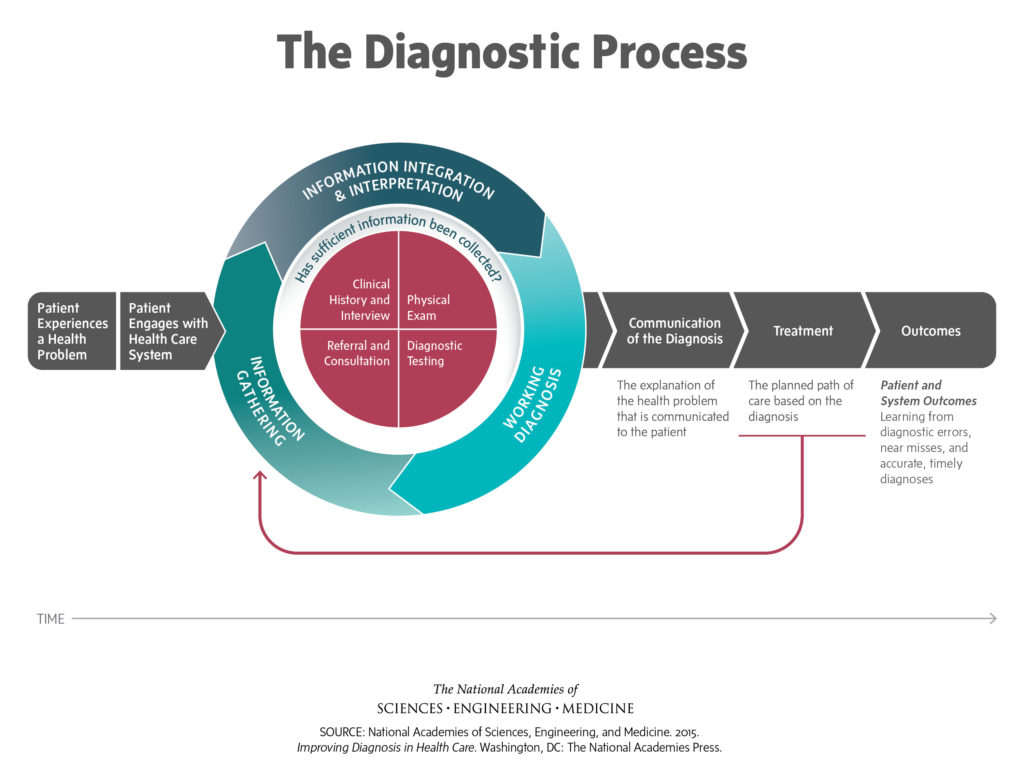The most important medical issue ever:
And why you need to know more about it
By Helene M. Epstein | January 8, 2019

Nothing much happens in healthcare without it but if it’s wrong, little else your doctor does can ever fully be right. And unfortunately, it can go wrong far too often.
Diagnosis
It is the cause of what ails you. It’s the linchpin for the medicines you take, the treatments you get, and the surgeries you may have. Diagnosis is a process that involves many people and moving parts, but it begins with you. You are the central member of a team of experts working to identify what is causing your symptoms.
Getting it right is so important, and not always easy to do. That’s why the Society to Improve Diagnosis in Medicine (SIDM) is sharing this series of columns. Our goal is to help you understand how important your role is. We want you to be informed and well prepared for every kind of medical interaction that leads to a diagnosis. We call it Dx IQ. Doctors and nurses refer to Diagnosis as Dx, the same way we refer to prescription medicines as Rx.
Your diagnosis is not something doctors can magically guess on their own when you walk into the exam room. It’s a vital team process that ideally begins when you visit your primary care doctor armed with information only you can share. The first steps are to review your history and your current symptoms, followed by a physical exam. Maybe your blood and urine will be tested. They may add more targeted tests depending on your symptoms. The tests for a headache will be different from those for chest pain or stomach issues or fever or backache.
The results of your history, physical exam, and any tests can be clues to identifying the cause of your symptoms. The answers could be very simple or extremely complex and difficult to figure out. That’s why getting the right diagnosis is a team effort, with all of the team members helping you get an answer to “Why do I feel like this?” You are a vital member and the more facts you can contribute the better.
Diagnosis. It is the cause of what ails you. It’s the linchpin for the medicines you take, the treatments you get, and the surgeries you may have.
There are three requirements for a good diagnosis; it should be Accurate, Communicated, and Timely (ACT). At SIDM, we’re leading a program called ACT for Better Diagnosis®. We also formed the Coalition to Improve Diagnosis, a group that includes the most well-known organizations in healthcare. Together we are working to find how to improve the diagnostic process, so all of us are healthier.
When Your Diagnosis is Wrong
Nine times out of ten you’ll end up with the correct diagnosis and treatment plan, but not always. That’s commonly called a misdiagnosis; in medicine it’s called a diagnostic (Dx) error. Both are broad terms that include when the cause of your illness is missed entirely, is mistaken for another disease or issue, or takes too long to identify or communicate.
We’ve mentioned that diagnosis is a process with many steps. Well, misdiagnosis is when one or more steps go wrong in that process. There are literally hundreds of steps and any of them could cause a delay or an error in figuring out the cause of your illness.
The odds that you or your family member will be misdiagnosed at some point in your life are nearly 100%. It happens to over 12 million American adults every year. In fact, every 9 minutes, someone dies due to it. It’s the #1 reason for malpractice suits. ECRI, an organization who helps direct the patient safety agenda for major hospitals and medical centers, named it the #1 patient safety issue for 2018.
There are two major reasons why misdiagnosis or Dx error can happen: system-related errors and cognitive errors. Usually an error is due to a combination of both.
A system-related error could happen when a test result is incorrect, or pinned to someone else’s medical records, or lost and no one notices. It could happen if you’re not called to come in for a follow-up or you forget to follow-up when you’re asked to do so. It could be due to a broken machine or an inaccurate blood pressure reading. Maybe an employee at the lab didn’t notify the physician’s office about a positive test result or a staff member at the doctor’s office didn’t tell you about it. When hospital doctors and nurses change shifts, they need to share all of the important information on each patient with the new team. Sometimes, key details get dropped. There are hundreds of possible system errors.
Cognitive errors cause missed and delayed diagnosis, too. A cognitive error means that one or more of the team members made a mental mistake. There are at least twenty possible cognitive errors and biases, but three are most common:
- Mistakes gathering your information. Perhaps the data in your chart is incomplete. It could be that the doctor failed to order a needed test or the nurse didn’t ask an important question. Perhaps the radiologist misread your chest x-ray or your CT scan. Or sometimes, you forgot to share an important detail.
- Mistakes in analyzing your information. Doctors and nurses use your symptoms, history, and test results to develop initial thoughts of what is causing your illness. There are several factors that impact their ability to do that correctly. Maybe the doctor overrates one test result or symptom over another. Maybe she fixes on the wrong fact as the most important. Experienced doctors may use shortcuts for identifying and solving problems. These shortcuts usually work well but they aren’t foolproof. Because it’s a mental short cut, the doctor may not consider the real cause of your concern, until your pain worsens or your disease progresses or the treatment plan fails.
- Premature closure. This is a failure to consider other possibilities once the original diagnosis has been reached. For example, your child was banged up when he fell playing football so all of his symptoms are blamed on the fall, but an inner ear infection that caused the fall is missed. Women’s heart issues can be harder to recognize than men’s, so premature closure might mean the doctor doesn’t even consider a cardiac workup.

What Can You Do?
Remember, you are the central member of the diagnostic team. Being prepared makes it easier for you to participate and to be heard fully. To help you be the best team member for your own health needs, here are two valuable tools you can start using today:
- The SIDM Patient Toolkit is a handy step-by-step workbook with sections to fill out before, during and after your doctor’s appointment.
- The Patient Checklist is a joint effort of SIDM, the National Patient Safety Foundation, and the Cautious Patient Foundation to develop an easy-to-follow checklist. It is available free on our Additional Patient Resources page or you can get the PDF by clicking here.
Don’t forget to visit us here or follow our Facebook page. Both offer monthly columns and important articles about what you can do about the most important medical issue ever: getting the right diagnosis.
The Society to Improve Diagnosis in Medicine (SIDM) catalyzes and leads change to improve diagnosis and eliminate harm from diagnostic error. We work in partnership with patients, their families, the healthcare community, and every interested stakeholder. SIDM is the only organization focused solely on the problem of diagnostic error and improving the accuracy and timeliness of diagnosis. In 2015, SIDM established the Coalition to Improve Diagnosis, to increase awareness and actions that improve diagnosis. Members of the Coalition represent hundreds of thousands of healthcare providers and patients—and the leading health organizations and government agencies involved in patient care. Together, we work to find solutions that enhance diagnostic safety and quality, reduce harm, and ultimately, ensure better health outcomes for patients. Visit our website at www.improvediagnosis.org, and follow us on Twitter or Facebook.
Helene M. Epstein writes about patient safety and family health. Her goal is to help readers apply important new information to their own lives. Subscribe to her website at www.hmepstein.com and follow her on Twitter or Facebook.
Dx IQ is made possible with funding from the Mont Fund and the Gordon and Betty Moore Foundation.

This work is licensed under a Creative Commons Attribution-NonCommercial-NoDerivatives 4.0 International License.
Republish our Dx IQ articles for free, online or in print, under Creative Commons license. Please do not edit the piece. Ensure that you attribute the author and mention that the article was originally published by the Society to Improve Diagnosis in Medicine. If you republish, we’d love for you to let us know by sending an email to info@improvediagnosis.org.
Resources for Patients
At SIDM, we are focused on raising awareness about the magnitude and impact of diagnostic errors and providing tools and resources to equip patients to participate in achieving an accurate and timely diagnosis.


